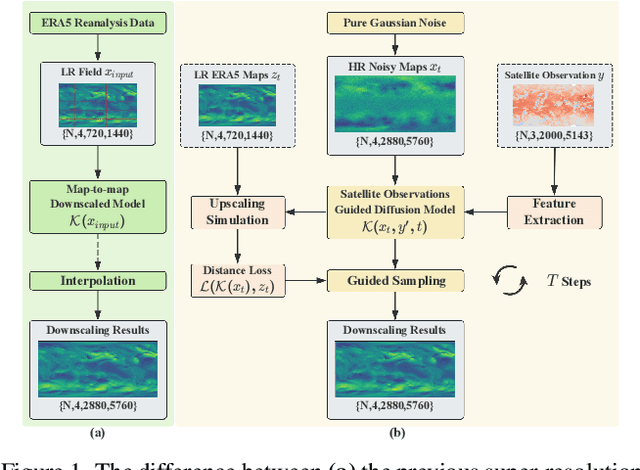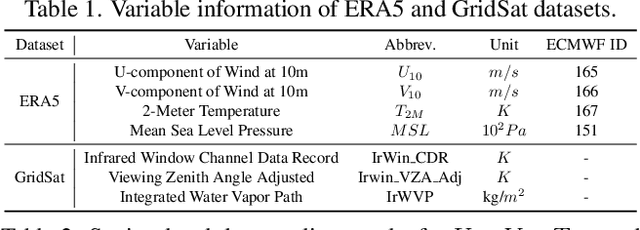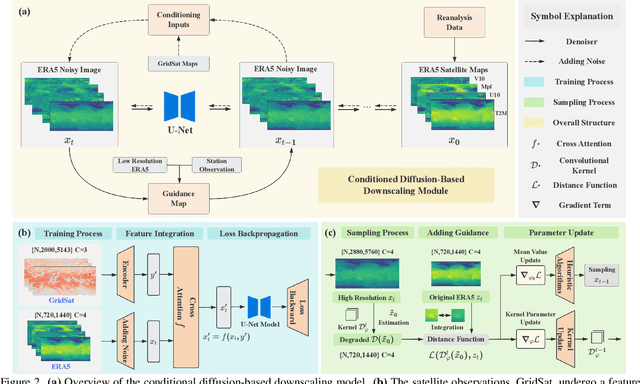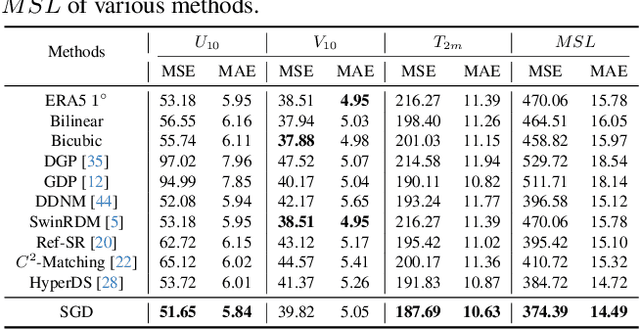Siwei Tu
Satellite Observations Guided Diffusion Model for Accurate Meteorological States at Arbitrary Resolution
Feb 09, 2025



Abstract:Accurate acquisition of surface meteorological conditions at arbitrary locations holds significant importance for weather forecasting and climate simulation. Due to the fact that meteorological states derived from satellite observations are often provided in the form of low-resolution grid fields, the direct application of spatial interpolation to obtain meteorological states for specific locations often results in significant discrepancies when compared to actual observations. Existing downscaling methods for acquiring meteorological state information at higher resolutions commonly overlook the correlation with satellite observations. To bridge the gap, we propose Satellite-observations Guided Diffusion Model (SGD), a conditional diffusion model pre-trained on ERA5 reanalysis data with satellite observations (GridSat) as conditions, which is employed for sampling downscaled meteorological states through a zero-shot guided sampling strategy and patch-based methods. During the training process, we propose to fuse the information from GridSat satellite observations into ERA5 maps via the attention mechanism, enabling SGD to generate atmospheric states that align more accurately with actual conditions. In the sampling, we employed optimizable convolutional kernels to simulate the upscale process, thereby generating high-resolution ERA5 maps using low-resolution ERA5 maps as well as observations from weather stations as guidance. Moreover, our devised patch-based method promotes SGD to generate meteorological states at arbitrary resolutions. Experiments demonstrate SGD fulfills accurate meteorological states downscaling to 6.25km.
Large Generative Model-assisted Talking-face Semantic Communication System
Nov 06, 2024



Abstract:The rapid development of generative Artificial Intelligence (AI) continually unveils the potential of Semantic Communication (SemCom). However, current talking-face SemCom systems still encounter challenges such as low bandwidth utilization, semantic ambiguity, and diminished Quality of Experience (QoE). This study introduces a Large Generative Model-assisted Talking-face Semantic Communication (LGM-TSC) System tailored for the talking-face video communication. Firstly, we introduce a Generative Semantic Extractor (GSE) at the transmitter based on the FunASR model to convert semantically sparse talking-face videos into texts with high information density. Secondly, we establish a private Knowledge Base (KB) based on the Large Language Model (LLM) for semantic disambiguation and correction, complemented by a joint knowledge base-semantic-channel coding scheme. Finally, at the receiver, we propose a Generative Semantic Reconstructor (GSR) that utilizes BERT-VITS2 and SadTalker models to transform text back into a high-QoE talking-face video matching the user's timbre. Simulation results demonstrate the feasibility and effectiveness of the proposed LGM-TSC system.
IceDiff: High Resolution and High-Quality Sea Ice Forecasting with Generative Diffusion Prior
Oct 10, 2024Abstract:Variation of Arctic sea ice has significant impacts on polar ecosystems, transporting routes, coastal communities, and global climate. Tracing the change of sea ice at a finer scale is paramount for both operational applications and scientific studies. Recent pan-Arctic sea ice forecasting methods that leverage advances in artificial intelligence has made promising progress over numerical models. However, forecasting sea ice at higher resolutions is still under-explored. To bridge the gap, we propose a two-staged deep learning framework, IceDiff, to forecast sea ice concentration at finer scales. IceDiff first leverages an independently trained vision transformer to generate coarse yet superior forecasting over previous methods at a regular 25km x 25km grid. This high-quality sea ice forecasting can be utilized as reliable guidance for the next stage. Subsequently, an unconditional diffusion model pre-trained on sea ice concentration maps is utilized for sampling down-scaled sea ice forecasting via a zero-shot guided sampling strategy and a patch-based method. For the first time, IceDiff demonstrates sea ice forecasting with the 6.25km x 6.25km resolution. IceDiff extends the boundary of existing sea ice forecasting models and more importantly, its capability to generate high-resolution sea ice concentration data is vital for pragmatic usages and research.
PostCast: Generalizable Postprocessing for Precipitation Nowcasting via Unsupervised Blurriness Modeling
Oct 08, 2024



Abstract:Precipitation nowcasting plays a pivotal role in socioeconomic sectors, especially in severe convective weather warnings. Although notable progress has been achieved by approaches mining the spatiotemporal correlations with deep learning, these methods still suffer severe blurriness as the lead time increases, which hampers accurate predictions for extreme precipitation. To alleviate blurriness, researchers explore generative methods conditioned on blurry predictions. However, the pairs of blurry predictions and corresponding ground truth need to be generated in advance, making the training pipeline cumbersome and limiting the generality of generative models within blur modes that appear in training data. By rethinking the blurriness in precipitation nowcasting as a blur kernel acting on predictions, we propose an unsupervised postprocessing method to eliminate the blurriness without the requirement of training with the pairs of blurry predictions and corresponding ground truth. Specifically, we utilize blurry predictions to guide the generation process of a pre-trained unconditional denoising diffusion probabilistic model (DDPM) to obtain high-fidelity predictions with eliminated blurriness. A zero-shot blur kernel estimation mechanism and an auto-scale denoise guidance strategy are introduced to adapt the unconditional DDPM to any blurriness modes varying from datasets and lead times in precipitation nowcasting. Extensive experiments are conducted on 7 precipitation radar datasets, demonstrating the generality and superiority of our method.
Taming Generative Diffusion for Universal Blind Image Restoration
Aug 21, 2024



Abstract:Diffusion models have been widely utilized for image restoration. However, previous blind image restoration methods still need to assume the type of degradation model while leaving the parameters to be optimized, limiting their real-world applications. Therefore, we aim to tame generative diffusion prior for universal blind image restoration dubbed BIR-D, which utilizes an optimizable convolutional kernel to simulate the degradation model and dynamically update the parameters of the kernel in the diffusion steps, enabling it to achieve blind image restoration results even in various complex situations. Besides, based on mathematical reasoning, we have provided an empirical formula for the chosen of adaptive guidance scale, eliminating the need for a grid search for the optimal parameter. Experimentally, Our BIR-D has demonstrated superior practicality and versatility than off-the-shelf unsupervised methods across various tasks both on real-world and synthetic datasets, qualitatively and quantitatively. BIR-D is able to fulfill multi-guidance blind image restoration. Moreover, BIR-D can also restore images that undergo multiple and complicated degradations, demonstrating the practical applications.
Personalized Wireless Federated Learning for Large Language Models
Apr 20, 2024



Abstract:Large Language Models (LLMs) have revolutionized natural language processing tasks. However, their deployment in wireless networks still face challenges, i.e., a lack of privacy and security protection mechanisms. Federated Learning (FL) has emerged as a promising approach to address these challenges. Yet, it suffers from issues including inefficient handling with big and heterogeneous data, resource-intensive training, and high communication overhead. To tackle these issues, we first compare different learning stages and their features of LLMs in wireless networks. Next, we introduce two personalized wireless federated fine-tuning methods with low communication overhead, i.e., (1) Personalized Federated Instruction Tuning (PFIT), which employs reinforcement learning to fine-tune local LLMs with diverse reward models to achieve personalization; (2) Personalized Federated Task Tuning (PFTT), which can leverage global adapters and local Low-Rank Adaptations (LoRA) to collaboratively fine-tune local LLMs, where the local LoRAs can be applied to achieve personalization without aggregation. Finally, we perform simulations to demonstrate the effectiveness of the proposed two methods and comprehensively discuss open issues.
 Add to Chrome
Add to Chrome Add to Firefox
Add to Firefox Add to Edge
Add to Edge